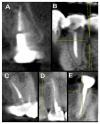Root Canal Configuration and Its Relationship with Endodontic Technical Errors and Periapical Status in Premolar Teeth of a Saudi Sub-Population: A Cross-Sectional Observational CBCT Study
- PMID: 36673896
- PMCID: PMC9859327
- DOI: 10.3390/ijerph20021142
Root Canal Configuration and Its Relationship with Endodontic Technical Errors and Periapical Status in Premolar Teeth of a Saudi Sub-Population: A Cross-Sectional Observational CBCT Study
Abstract
Endodontic technical errors are the foremost cause of treatment failure. A thorough understanding of root canal configuration (RCC) is essential to prevent these iatrogenic errors. This study used CBCT images to determine the association between root canal configuration, endodontic technical errors, and periapical status. CBCT images of 101 patients, including total of 212 obturated premolars (256 canals) were assessed. RCCs were classified according to the Vertucci system. The presence of endodontic errors and periapical lesions associated with each RCC was noted. Presence or absence of coronal restoration and its association with periapical radiolucency was recorded. The most frequent RCC was Type I (199 cases; 77.73%), followed by Type II (26 cases; 10.15%), Type IV (22 cases; 8.59%), Type V (4 cases; 1.56%), Type III (4 cases; 1.56%), and Type VI (1 case; 0.39%). Under-filling and non-homogeneous filling were the most common technical errors. Prevalence of periapical radiolucency was 81% in the presence of technical errors. The absence of coronal restoration caused apical lesions in 93% of cases. The frequency of endodontic technical errors increased as the root canal configurations became more complex. Periapical lesions occurred more often in teeth with endodontic errors and/or absent coronal restoration.
Keywords: cone-beam computed tomography; endodontic errors; endodontics; oral diseases; oral health; oral radiology; root canal configuration.
Conflict of interest statement
The authors declare no conflict of interest.
Figures


References
-
- Pedemonte E., Cabrera C., Torres A., Jacobs R., Harnisch A., Ramírez V., Concha G., Briner A., Brizuela C. Root and canal morphology of mandibular premolars using cone-beam computed tomography in a Chilean and Belgian subpopulation: A cross-sectional study. Oral. Radiol. 2018;34:143–150. doi: 10.1007/s11282-017-0297-5. - DOI - PubMed
-
- Al-Zubaidi S.M., Almansour M.I., Alshammari A.S., Al Mansour N.N., Alshammari A.F., Altamimi Y.S., Madfa A.A. Root and canal morphology of mandibular premolars in a Saudi subpopulation: A cone-beam computed tomography study. Int. J. Dent. 2022;2022:4038909. doi: 10.1155/2022/4038909. - DOI - PMC - PubMed
Publication types
MeSH terms
LinkOut - more resources
Full Text Sources

